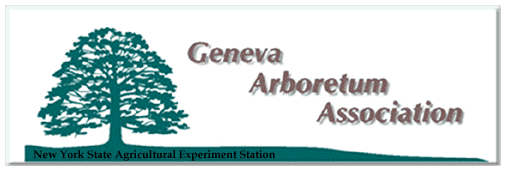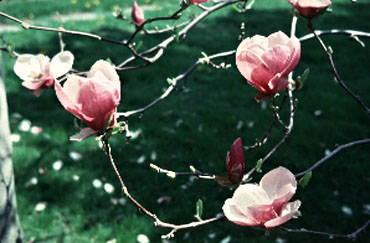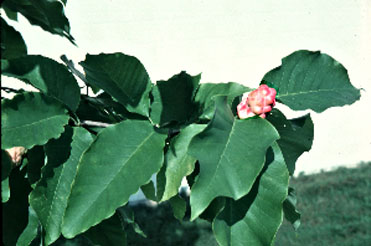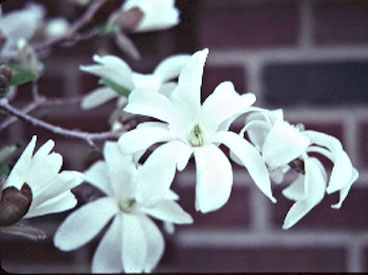

The Geneva campus has several species of the genus Magnolia
that develop large white or pink flowers in early spring. This early flowering
before the leaves is one of the things that distinguishes members of the
genus Magnolia from its Liriodendron cousins. It is a common
spring sight to see the large showy flowers of the widely-planted hybrid
saucer magnolia [Magnolia x soulangeana, (M. denudata x M.
liliflora)] throughout the eastern United States. Our campus has two
saucer magnolias, one located in the middle section of the Rock garden next
to the gold fish pond (now a tulip bed), the other planted at the west entrance
of the Food Science Building as a memorial to Audrey Gardner. This small
deciduous tree or shrub may reach 2030 ft in height. Saucer magnolia
has bright pink-to-purple saucer-shaped flowers (with surprisingly white
interiors) that can be up to six inches in diameter. Although these are
very stunning flowers to look at, they have little or no fragrance to accompany
all that beauty. Flowers open in late April to early May. Another distinctive
feature of these flowers is that they are enclosed within large furry buds,
which are covered by a single bud scale.

Our one magnolia native to this region of the country is Magnolia
accuminata, or cucumber tree. Our only example is located on the
lawn of the campus warehouse. This species grows to be a medium to large
tree with a wide rounded crown that reaches 50-80 ft in height. Its 3-inch-long
cup-shaped, yellow-green flowers appear in May after the leaves. It gets
its common name, cucumber tree, from the appearance of its fruit when young
and green.

Two other magnolias in our campus collection are Kobus magnolia and star
magnolia, both natives of Japan. OurMagnolia kobus is also
located on the campus warehouse lawn. Its flowers are 4-5 inches wide, appearing
in May before the leaves. Flowers are white with a purple base and are star-shaped.
This species may be a tree or small shrub reaching 30 feet. The star magnolia,
Magnolia stellata, is planted in several locations across
campus . You may see its cheerful white blossoms at both side entrances
of Hedrick Hall and on the lawn of the Food Science Building. The tree's
abundant flowers are double-petalled and very fragrant, appearing as three-inch
stars with faint pink streaks in late March or early April before the leaves.
The star magnolia is a slow growing, compact, and often wide-spreading shrub
or small tree that may eventually reach 15 ft in height. Both Kobus and
star magnolia flower buds, while not as large as those of the saucer magnolia,
are also densely hairy. The above two species make a great accent for a
dark wall or background with their white spring flowers, light green leaves
and red and black winter fruit. There is also a more shrub-like pink cultivar
of star magnolia, Magnolia stellata var. rosea. Rumor
has it that Spring has not come to Geneva until it snows at least once on
the star magnolia blossoms!

All of our magnificent magnolias make a nice addition to the home landscape
and are not difficult to grow if planted in a rather sunny area that offers
some protection from the north and east. They prefer rich well-drained garden
soil with high organic matter. One caution, however - once planted, do not
disturb the root systems, not even to plant spring bulbs!
by Cathy Heidenreich
Next (Eastern Redbud)
Return to Arboretum Home Page
Return to NYS Agricultural Experiment Station Home Page